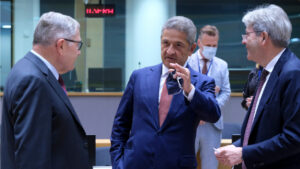
The Federal Reserve Building in Washington.
Olivier Douliery/AFP via Getty Images
Much like Thomas Jefferson, Milton Friedman has been reappraised based on current attitudes. To be sure, it hasn’t been comparable to the revised view of the main author of the Declaration of Independence, whose claim that all men are created equal now is seen as hypocritical, at best, given his ownership of slaves. But the assertion of the late Nobel Laureate in economics that the social responsibility of business is to maximize profits is out of step with today’s ESG movement, which gives equal priority to environmental, social, and governance factors.
Almost as passe is Friedman’s dictum that inflation is everywhere and always a monetary phenomenon. Given the Federal Reserve’s previous inability to get inflation to reach its putative 2% target, especially in the years following the 2007-09 financial crisis—despite then-unprecedented monetary expansion and 0% interest rates—the idea that money matters no longer appeared to carry much weight among economists.
The current surge in inflation seems tied mainly to the effects of the pandemic, which has led to shortages of everything, owing both to snarled supply chains as well as the reluctance of many people to return to work.
But the basic tenets of monetary theory may be about to be relearned. So writes Deutsche Bank macro strategist Alan Ruskin, who warns that the money-supply explosion that powered the economy’s rebound from its record contraction last year, along with the rally in everything from stocks to houses, will be followed by nasty aftereffects. The inflation will prove to be more than transitory, despite what Fed officials assert, leading to what he sees as “a hangover like no other,” as he titles his report.
The metaphor seems especially apt. As with alcohol, the initial effects of monetary expansion are pleasant, even exhilarating. The positive impact on asset prices is viewed by policy makers as a sign of the effectiveness of their actions rather than the earliest symptom of inflation, Ruskin explains. That’s followed by good news on real economic growth, which further produces what he calls a “policy illusion” that leads policy makers not to worry about inflation.
Once inflation takes off, it usually coincides with slowing real growth, leading to a conundrum. Policy makers typically expect the slower growth to solve the problem, which only leads to delayed action to counter inflation. That produces the worst of all worlds, sluggish growth along persistent price pressures—or, colloquially, stagflation, the term originated in the 1970s when this toxic combination emerged.
Back then, Ruskin points out, Keynesians focused on supply-related cost pressures following the surge in energy prices, which raised inflation expectations for businesses and labor. Monetarists like Friedman focused on liquidity measures, which fueled strong demand and price pressures, while supply shocks such as OPEC price hikes tended to be one-off and short-lived.
This monetary expansion has dwarfed previous ones, Ruskin notes. Broad money supply (M2) growth is 23% above its pre-Covid-19 trend, which is the result of the Fed’s quantitative-easing program of buying $120 billion of Treasury and agency securities every month. And relative to their pre-Covid trends, the S&P 500 is 28% higher, adding some $10 trillion in market capitalization, while house prices are 12% above trend, based on CoreLogic data, adding another $4 trillion to household wealth, he adds.
But the pleasant effects of monetary expansion are felt first. Money supply growth lifts real economic growth with a two-to-three-quarter time lag. Based on the Fed’s median forecast, real gross domestic product is expected to grow 5.9%, measured from the fourth quarter of 2021 from the fourth quarter of 2020, which would be viewed as a boom any other time.
The impact on inflation is felt with a much longer lag, some 18-24 months. That’s the hangover effect. As such, Ruskin writes inflation pressures won’t peak until mid-2022 at the earliest, and much later, if monetary accommodation persists.
On that score, the Fed is expected to announce only the beginning of the tapering of its bond buying at its Nov. 3 policy meeting, which then wouldn’t wind up until sometime in the middle of next year. Even then, if the central bank trims its purchases by $15 billion per month, it will still add another $400 billion to its $8 trillion portfolio before it’s done.
Thus, there’s no sign of less-loose money that would portend any slowdown but still points to persistent inflation into 2022, Ruskin says. Even given supply-chain effects, monetary policy continues to prop up these inflationary impulses.
“It also means that policy makers cannot cop-out in blaming a supply-side snarl. A monetary problem requires a monetary solution,” he concludes. For investors used to imbibing central-bank liquidity, that would promise a painful hangover.
Write to Randall W. Forsyth at randall.forsyth@barrons.com
- "
- 2020
- 2021
- Action
- Alan
- Alcohol
- All
- among
- APT
- asset
- Bank
- BEST
- Billion
- boom
- Briefing
- Building
- business
- businesses
- Buying
- capitalization
- Central Bank
- Commentary
- continues
- creator
- Current
- data
- day
- Demand
- Deutsche Bank
- Economic
- Economic growth
- Economics
- energy
- environmental
- ESG
- Exclusive
- expansion
- Fed
- Federal
- federal reserve
- financial
- First
- follow
- For Investors
- good
- governance
- Grow
- Growth
- House
- household
- houses
- HTTPS
- ICON
- idea
- Impact
- Including
- inflation
- interest
- Investors
- IT
- labor
- leading
- Led
- Liquidity
- Macro
- Market
- Market Capitalization
- Matters
- Men
- money
- months
- news
- Other
- pandemic
- People
- policy
- portfolio
- price
- Product
- Program
- purchases
- rally
- report
- Securities
- sees
- shortages
- Slowing
- So
- Social
- SOLVE
- Stocks
- supply
- Supply chains
- surge
- Target
- time
- treasury
- Trends
- W
- washington
- Wealth
- WHO
- wind
- year
- years




